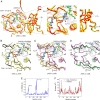2'-O methylation of RNA cap in SARS-CoV-2 captured by serial crystallography
- PMID: 33972410
- PMCID: PMC8166198
- DOI: 10.1073/pnas.2100170118
2'-O methylation of RNA cap in SARS-CoV-2 captured by serial crystallography
Abstract
The genome of the severe acute respiratory syndrome coronavirus 2 (SARS-CoV-2) coronavirus has a capping modification at the 5'-untranslated region (UTR) to prevent its degradation by host nucleases. These modifications are performed by the Nsp10/14 and Nsp10/16 heterodimers using S-adenosylmethionine as the methyl donor. Nsp10/16 heterodimer is responsible for the methylation at the ribose 2'-O position of the first nucleotide. To investigate the conformational changes of the complex during 2'-O methyltransferase activity, we used a fixed-target serial synchrotron crystallography method at room temperature. We determined crystal structures of Nsp10/16 with substrates and products that revealed the states before and after methylation, occurring within the crystals during the experiments. Here we report the crystal structure of Nsp10/16 in complex with Cap-1 analog (m7GpppAm2'-O). Inhibition of Nsp16 activity may reduce viral proliferation, making this protein an attractive drug target.
Keywords: CAP-1; Nsp10/16; SARS-CoV-2; mRNA; serial crystallography.
Copyright © 2021 the Author(s). Published by PNAS.
Conflict of interest statement
The authors declare no competing interest.
Figures




References
-
- Muthukrishnan S., Moss B., Cooper J. A., Maxwell E. S., Influence of 5′-terminal cap structure on the initiation of translation of vaccinia virus mRNA. J. Biol. Chem. 253, 1710–1715 (1978). - PubMed
Publication types
MeSH terms
Substances
Grants and funding
LinkOut - more resources
Full Text Sources
Other Literature Sources
Research Materials
Miscellaneous

